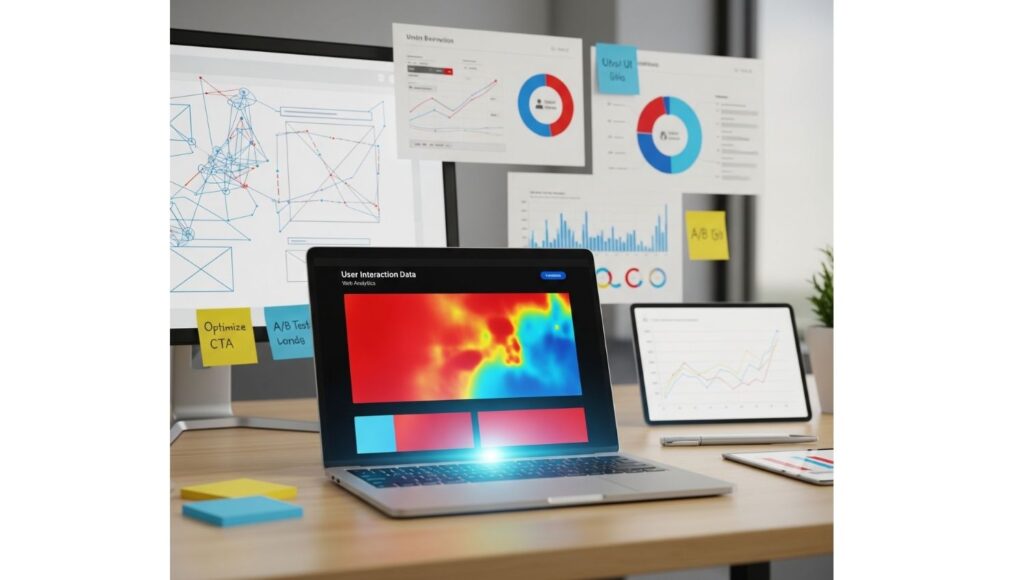Heatmap Tools to Better Landing Page Design
Table of Contents

Your landing page is where the money is made. But how do you know what is performing and what isn’t? That’s where heatmap tools enter the picture — providing a visual snapshot of how users are engaging with your page. These tools are nicer than they look; they’re conversion goldmines.
In this article, we’re going in-depth on:
- What are heatmap tools
- How do they enhance landing page performance
- Types of heatmaps you should use
- In-depth analysis of popular tools
- Step-by-step guide to use them optimally
- Practical optimization examples
- Best practices for heatmap analysis
Let’s unleash the untapped potential of your landing pages.
What are Heatmap Tools?
A heatmap is a visual outline of what users do. It reveals where users click, scroll, and move their cursors. The warmer the color (such as red, orange), the greater activity; the cooler the color (blue, green), the lower the engagement.
Purpose of a Heatmap Tool:
- See how users interact with your landing page
- Find distractions or dead zones
- Find usability problems
- Optimize CTAs, images, and form placement
- Boost conversion rates through enhanced UX
Why Heatmaps Matter for Landing Pages
Landing pages are built to do one thing: convert visitors into customers or leads. If users aren’t viewing what’s most important, or things are in the wrong location — you’re losing money.
Advantages of Heatmap Utilization:
- Visual Insight: No guessing anymore. You know exactly what users are doing.
- Behavior-Driven Layout Changes: Don’t guess – make layout changes based on what users are doing.
- Better User Experience: You can spot friction points and optimize for easier navigation.
- Improved ROI: An optimized landing page = improved ad spend efficiency and more conversions.
Most Common Types of Heatmaps You Should Use
Various types of heatmaps provide different insights. Here are the most critical ones:
1. Click Maps
Shows where users are clicking on your landing page. You’ll discover:
- Which buttons are clicked the most
- Whether non-clickable elements are confusing users
- How effective your CTA buttons are
2. Scroll Maps
Tracks how far down users scroll. This helps you:
- See if users are reaching your CTA or offer
- Adjust content layout to ensure visibility of key sections
- Know where engagement drops off
3. Move Maps (Mouse Tracking)
Displays where users move their pointer. Typically aligned with eye movement:
- Make sense of visual attention hotspots
- Refine image and copy placement
4. Attention Heatmaps
These extract eye tracking data and display where users visually attend. Suitable for:
- Validating visual hierarchy
- Enhancing content layout and design priority
Best Heatmap Tools to Use
1. Hotjar
Among the most used ones. Hotjar provides:
- Click, scroll, and move maps
- Session recordings
- Incoming feedback polls
Why it’s great: It’s easy to get started with, integrates smoothly with CMS platforms such as WordPress, and has extra feedback tools.
2. Crazy Egg
Strong tool with:
- Heatmaps
- Scrollmaps
- Confetti maps (displays clicks by referral source)
Why it’s great: Great for A/B testing and segmented behavior insights.
3. Microsoft Clarity
Powerful and free Microsoft tool with:
- Click heatmaps
- Scroll tracking
- Session replays
- Rage click detection
Why it’s great: Free forever, no traffic limits, strong data filtering.
4. Smartlook
Apart from heatmaps, Smartlook also offers:
- Session recordings
- Funnel analytics
- Event tracking
Why it’s great: Best for ecommerce and SaaS companies to visualize user paths.
5. Lucky Orange
All-in-one conversion optimization suite:
- Heatmaps
- Session recordings
- Live chat
- Surveys
Why it’s great: Has live session viewing and heatmap comparison for A/B testing.
How to Use Heatmap Tools Effectively
Step 1: Define Your Objective
What do you want to know? Example goals:
- Is the CTA being clicked?
- Are they making it to the sign-up form?
- Is the hero image getting attention?
Step 2: Set Up the Tool
Install tracking script on your landing page (through plugin or direct insertion in HTML head section).
Step 3: Allow Data Collection
Let the heatmap gather data for at least 500–1000 visitors for accurate results.
Step 4: Interpret the Data
- Red = High engagement
- Blue = Low engagement
- Empty spaces = Trouble spots
Check for trends: Are users clicking non-link elements? Are they avoiding CTAs?
Step 5: Make Strategic Adjustments
Tweak based on what you observe:
- CTA placement and color
- Headline location
- Image size or layout
- Eliminate distractions
Step 6: A/B Test Changes
Use A/B tests to confirm improvements. Keep iterating on new heatmap results.
Real-World Landing Page Optimization Example
Scenario:
A software as a service is below the fold, and the team employs a heatmap to explore.
Findings:
- Users rarely scroll beyond the hero section.
- High attention is given to the “Features” section.
- A non-clickable image receives high frequencies of clicks.
Changes Made:
- CTA relocated to the hero section with a colorful button.
- Added anchor links to make the image clickable.
- Minimized content below the fold.
Result:
- Bounce rate decreased by 22%
- Conversions went up by 38%
- Users spent more time interacting
Best Practices for Using Heatmap Tools
- Use with A/B Testing Tools
Heatmaps are strongest when combined with A/B tests. Use Google Optimize, VWO, or Optimizely to confirm results.
- Pair with Analytics Heatmaps indicate what users are doing. Google Analytics indicates who and why. Use both.
- Track Mobile & Desktop Separate Behavior of users varies across devices. Make mobile and desktop separate heatmaps.
- Go Beyond the Obvious Just because it’s red doesn’t mean it is good. Are people clicking it on purpose or because they are confused?
- Prioritize Conversion Elements Take a close look at heat around:
- CTA buttons
- Forms
- Pricing areas
- Testimonials
- Navigation links
- Don’t Over-Interpret A Single Session Heatmaps need to be looked at over time and across sufficient traffic. Don’t redesign based on 5 clicks.
Common Mistakes to Avoid
- Over-relying on one type of heatmap: Use a combination for better insights.
- Using small sample sizes: Wait for enough data before acting.
- Ignoring scroll depth: If your CTA is too low, it won’t get clicks.
- Misjudging click behavior: Not all clicks indicate interest; some show confusion.
- Forgetting mobile UX: Always check mobile-specific behavior.
How Heatmap Tools Fit into a Larger CRO Strategy
Heatmaps are a key element in your Conversion Rate Optimization (CRO) toolkit. But they should be used in conjunction with:
- Session recordings
- Analytics tools
- Feedback surveys
- User testing
Together, these tools provide a 360-degree view of your landing page performance.
Metrics to Monitor After Making Changes
After implementing insights from heatmaps, monitor:
- Conversion rate
- Bounce rate
- Average session duration
- Scroll depth
- Click-through rate (CTR) on CTAs
Track these over time to evaluate the true impact of your improvements.
Final Thoughts
Your landing page is your brand’s first impression. Heatmap tools take the guesswork out of improving that impression. Instead of wondering why users didn’t convert, you’ll have clear, actionable visual data.
Whether you’re using Hotjar, Clarity, or Crazy Egg, the goal remains the same: create user-first landing pages that convert.
“If you know where people are looking, you can lead them where you want them to go.”


